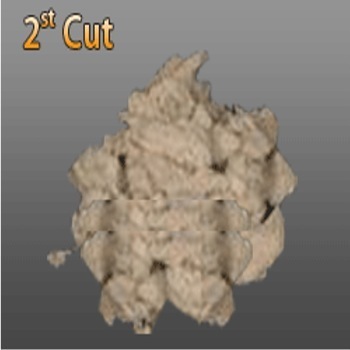 |
 PRODUCTS PRODUCTS
|
 |
 |
 |
 |
| |
|
Even after employing the most efficient ginning process for recovery of lint from seed cotton, a certain amount of fuzz (very short fibers unsuitable for spinning) remains on the cottonseeds. This fuzz is known as “Cotton Linters”. The linters can be recovered by a special machine called “DELINTER”. If it is recovered in defibrators, another type of machine, it is known as “HULL FIBRES”. Delinters can remove the fuzz in a single passage or in two or three passages. The linters removed in a single passage are designated as “MILL RUNS” and if properly recovered, are usually composed of short and long fibres (2.5 to 12 mm long). If they are recovered in two passages, the first passage linters are known as 1st Cut Linters – usually 6 to 12 mm fibre length and the second passage linters are known as 2nd Cut Linters, usually having fibre length less than 5 to 6 mms. Some times the seeds are subjected to third passage and are known as 3rd Cut Linters having fibre length ranging between 2 to 3 1/2 mm.
|
|
 |
|
 |
|
Recovery of linters from Cottonseed is about 4 per cent. |
|
|
USES: |
|
|
The Linters are used in the manufacture of paper, low grade absorbant cotton and in the mattress industry. Pure 1st Cut Linters are prized raw material for high grade bond, currency, low grammage tissues and filter paper. Bleached Cotton Linters are being used by our Ordinance Factories for production of propellants used for gun ammunition & also various missiles. For production of propellants, one of the basic explosive is Nitrocellulose(NC). Basic raw material for production of Nitrocellulose(NC) is Bleached Cotton Linters(BCL) which is produced out of raw cotton linters after processing. Further, bleached cotton can also be useful for surgical use as well as Felt making, Paper making and Cellulose Acetate, which is used in Rayan Fiber and Photographic Films etc. |
|
|
In U.S.A. the tissue papers prepared out of linters are reported in demand, especially by ladies for removal of make-up since it is not considered sensitive to the skin and is of organic origin. Market for such tissue papers can be developed in India also. |
|
|
CAPOL produces around 2,500 MT per annum of Cotton Linters, which are being exported to European Countries and East Asian Countries. |
|
|
| |
|
|
|
 |
 |
|
|
 |
